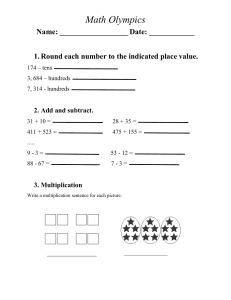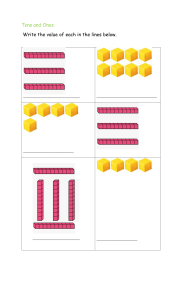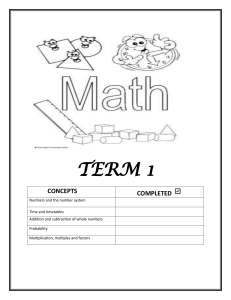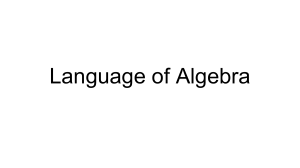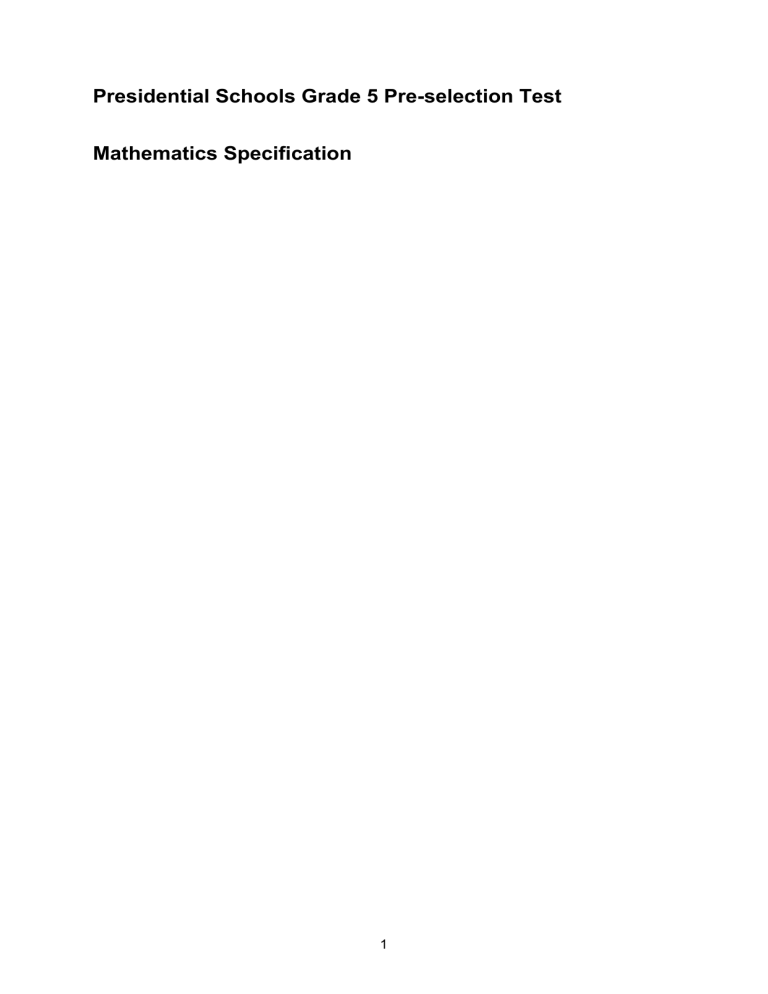
Presidential Schools Grade 5 Pre-selection Test Mathematics Specification 1 Contents 1 Structure of the Mathematics test ........................................................................ 3 2 Sample questions ................................................................................................ 4 3 Subject content .................................................................................................... 7 4 Rules for selecting candidates for admission ..................................................... 13 2 1 Structure of the Mathematics test The Mathematics test will consist of one 60-minute paper. The paper will contain 30 multiple-choice questions. Each question is worth one mark. Questions will test a range of knowledge and skills, including number and calculation, algebra, geometry, data and problem solving within a mathematics context. Questions will have five options from which candidates select one option. Candidates record their answers on a separate answer sheet, which will be scanned. There will be no penalty for incorrect answers, so candidates are advised to answer all the questions in the paper. Calculators, mobile phones and any other electronic devices and unauthorized materials, such as dictionaries, are not allowed. 3 2 Sample questions These sample questions are provided to give an indication of the types of questions that will appear in the test. They are not intended to be a comprehensive description of all of the types of questions that will be used. Example 1 Aziz has 136 coloured pencils. Zebo has 38 coloured pencils. Kamola has 29 coloured pencils. Kamola gives Aziz all her coloured pencils. Now, how many more coloured pencils does Aziz have than Zebo? A 98 B 127 C 133 D 145 E 165 Correct answer: B Example 2 Δ is a whole number. 67 – 2 × Δ + 49 = 100 Find the value of Δ. A 3 B 6 C 8 D 13 E 16 Correct answer: C 4 Example 3 Here is a sequence of numbers. ; 3; 6; 12; ; 48 Two numbers are missing. What is the sum of the two missing numbers? A 15 B 19,5 C 24 D 25,5 E 30 Correct answer: D Example 4 A square of side length 6 cm and a square of side length 4 cm are joined together to make a new shape. What is the perimeter of the new shape? A 24 cm B 32 cm C 36 cm D 40 cm E 52 cm Correct answer: B 5 Example 5 An isosceles triangle has a perimeter of 18 cm. The length of one of the sides is 8 cm. What is the shortest possible side length in the triangle? A 2 cm B 4 cm C 5 cm D 6 cm E 8 cm Correct answer: A Example 6 p = 36, q = 6, r = 4 and s = 3 Which of these statements is/are correct? I. p + q : s = 38 II. p : q × s = 18 III. p – s × s + r = 31 A I only B II only C I and III only D II and III only E All of them Correct answer: E 6 3 Subject content The questions in the Pre-selection test may assess learning in any of the following topic areas. Questions will focus mainly on topic areas studied in Grade 4. However, these topics build on those already studied in Grades 1-3. Grade 4 topic areas 1 2 3 4 5 6 7 8 9 10 11 12 13 16 17 18 19 20 21 22 23 24 25 26 27 Multidigit numbers Decimal numeration system Multidigit numbers. Number position Lines’ perpendicularity Four arithmetic operation and their execution order Polyhedron Rectangular parallelepiped. Cube Writing technics of adding and subtracting Parallel lines Velocity. Time. Distance Multiplying by a one-digit number Dividing by a one-digit number Coordinate plane (I quadrant) Quadrantal angle Multiplying by numbers ending with zeros Graphs Diagrams. Tables Dividing by numbers ending with zeros Multiplying by two-and three-digit numbers Fractions Dividing by two-and three-digit numbers Statements (sentences) Using of calculator Division with remainders Addition of fractions with the same denominator Subtraction of fractions with the same denominator Comparison of fractions with the same denominator 7 Grade 3 topic areas 1 2 3 4 5 6 7 8 9 10 11 12 13 16 17 18 19 20 21 22 23 24 25 26 27 28 29 30 31 32 33 34 35 36 37 38 39 40 41 42 43 44 45 46 47 48 Repeating of the material studied in previous grades Expressions with brackets and without them Adding and subtracting of two-digit numbers with transition through tens Expressions with brackets Associative law of addition Subtracting sum from a number Subtracting difference from a number Relation between multiplication and division Multiplying a number by 0 and 1 Dividing 0 by a number. Dividing a number by 1 Dividing a number by a number Commutative law of multiplication Multiplication and division grid Finding of a number’s part. Finding a number knowing it’s part. Extra grid multiplication and division Calculations of type 20*3, 3*20 Calculations of type 60:3, 100:2 Calculations of type 90:30 Multiplication of a sum by a number or a number by a sum Calculations of type 24*3, 3*24 Expressions containing terms with letters Dividing sum by a number Calculations of type 39:3, 42:3, 72:4 Checking of division Dividing two-digit number by two-digit number Checking of multiplication Division with remainder (within the multiplication and division grid) Division with remainder beyond the table Checking of division with reminder Multiplication of three and more multipliers Numbering of three-digit numbers Hundreds Composing numbers from hundreds, tens and ones. Tree digit numbers Relation between thousands, hundreds, tens and ones. Representation of tree digit numbers as a sum of hundreds, tens, ones Comparison of tree digit numbers Units of length. Kilometre A tenfold increase. A hundredfold increase A tenfold decrease. A hundredfold decrease Equation containing unknown summand Equations of type x – 27 = 54, 63 – x = 26 Equation containing unknown multiplier Equations of type x : 3 = 12, 56 : x = 14 Types of angles Types of triangles Addition and subtraction within 1000 Methods of calculation Expressions of type 240 + 80, 240 – 80, 320 + 250, 580 – 350 8 49 50 51 52 53 54 55 56 57 58 59 60 61 62 63 64 65 66 67 68 69 70 71 72 73 74 75 Roman numbers Units of mass. Kilogram. Gram. Ton. Adding and subtracting without transition through tens and hundreds Adding with transition through tens, hundreds Time units. Year, month, week, day, hour, minute. Subtracting with transition through tens, hundreds Expressions of type 504 – 265 Equations of type x + 125=142, 156 + x = 342 Equations of type x - 125 = 142, 236 – x = 158, x – 305 = 601 – 98, 917 – x = 328 39 Multiplication and division within 1000 Multiplication and division by 1 and 0 Multiplication and division by 10 and 100 Expressions of type 30 * 4, 200 * 3, 320 * 3 Expressions of type 800 : 4, 490 : 7, 600 : 20, 900 : 300, 240 : 30 Time units: seconds Digital clock Century. Table of the time units Multiplication without transition through tens and hundreds Commutative law of multiplication Multiplication with transition through tens and hundreds Expressions of type 396 : 3, 346 : 2, 852 : 4, 216 : 3, 276 : 4, 668 : 4, 742 : 7 Checking multiplication using division Checking division using multiplication Division with remainder and its checking Equations of the type x*4=140, 3*x=126, x:3=258, 581:x=7 Value of expressions a + b, a – b, a * b, a : b Square decimetre Comparison of figure areas 9 Grade 2 topic areas 1 2 3 4 5 6 7 8 9 10 11 12 13 16 17 18 19 20 21 22 23 24 25 26 27 28 29 30 31 32 33 34 35 36 37 38 39 40 41 42 43 44 45 46 47 48 49 50 51 Simple tasks on finding sum and difference Tasks with equal results Checking of addition Checking of subtraction Right angle. Not right angle Perimeter of a polygon Number line and its models Addition and subtraction within 100 with transition through tens. Solving simple and compound problems Digit’s place value for two-digits numbers Column method of addition Working out the next terms of a sequence Model of a coordinate system from the day-to-day life Methods of subtraction within 100 with transition through tens Column method of subtraction Compound problems on subtraction Time units: hour, minutes. Simple problems on determining time, distance, velocity Transformation of simple figures into complex ones and vice-versa Property of the opposite sides of rectangle Square Relation between components and results of addition and subtraction Geometrical figures and values Sum of several equal summands Designation of a number as a sum of several equal summands Solving simple and compound problems Literal expressions Designation of geometrical figures Equations. Equation solving by trial and error method Multiplying. What this operation used for Multipliers and product Relation between components and results of multiplication Dividing. What this operation is used for Dividing into equal parts. Part of a whole Solving the problem using multiplying and dividing Table method of problem solving Finding of unknown multiplier Finding of unknown dividend Millimetre Multiplying by 0, 1, 10 Dividing by 1, 10 Expressions with brackets and without them Order of calculations in the expressions with brackets and without them Multiplication and division within 100. Multiplication and division grid. Multiplying of a single-digit numbers and dividing by them Compound problems Fractions. Fractions of a number Names and designation of fractions Composing and solving a problem Geometrical figures: square, rectangle, triangle, circle, and related values Comparison and colouring the figures. Constructing a figure from parts and dividing it into parts. 10 52 53 54 55 56 57 58 59 60 61 62 63 64 65 66 67 68 Correct writing of dividend, dividend, quotient and remainder Area of a rectangle and a square Unit of area: square centimetre, and its notation cm2 Area of figures drawn on the squared paper Notation of the three-digits numbers Composing numbers using hundreds, tens, ones Representation of three-digit numbers as a sum of hundreds, tens, ones Comparison of three-digit numbers Verbal and written numbering within thousand Unit of length: kilometre Relation between thousands, hundreds, tens and ones A number 1000 Multiplying and subtracting within 1000 Circle and circumference. Centre, radius, diameter of the circle. Pair of compasses Positional relationship of two circles on a plane Finding of a number’s part. Finding a number knowing it’s part. Comparison of parts. 11 Grade 1 topic areas 1 2 3 4 5 6 7 8 9 10 11 12 13 16 17 18 19 20 21 22 23 24 25 26 27 28 29 30 31 32 33 34 35 36 37 38 Objects and their properties Numbers from 1 to 10. Comparison of the numbers from 1 to 10 Designation of time Even and odd numbers Point. Line segment. Polygonal and curve lines Addition and subtraction of number 0 Summands and sum To add, to subtract. Meaning Numbers from 11 to 20 Brackets Addition pairs that make 10 Subtraction of single digits within ten Reading and writing of numbers from 21 to 100 Counting in tens Length and its unit: centimetre Angle and its types Polygons Learning to solve problems Textual tasks with addition and subtraction Unit of mass: kilogram Unit of volume: litre Subjects’ reflection in a mirror Plane figures and solids Units of length: decimetre and metre Numerical expressions. Tables Compound tasks How to get the whole from the parts, and parts from the whole Subtraction of a single digit from 100 Subtraction of a two-digit number from 100 Finding of a third summand Working out the next terms of a sequence Logical concepts “everything”, “half”, “the rest” Measurement and comparison of lengths and distances Constructing of different figures Solving of intriguing problems 12 4 Rules for selecting candidates for admission Scores in the Pre-selection Test are used to select the 480 most able applicants in each region, who then go forward to take the final Selection Test for admission to a Presidential School. To ensure that candidates cannot be advantaged or disadvantaged by any slight differences that might exist in the overall difficulty of the test papers used for different test sittings, a process called Rasch analysis is used to equate the test scores. Instead of candidates being ranked on the basis of their actual score out of 30, they are ranked on the basis of their underlying ability score, which in this case is reported on a scale out of 100. There is a trend of gradually increasing question difficulty as the Pre-selection Test proceeds. Where more than one candidate has the same ability score for the whole test, they are therefore ranked in the following order: 1. The candidate who scored highest on Questions 21-30. 2. (If still tied) the candidate who scored highest on Questions 11-20. 3. (If still tied) the candidate who scored highest on Questions 1-10. If the candidates’ scores are still tied, the younger candidate will be ranked higher. 13
